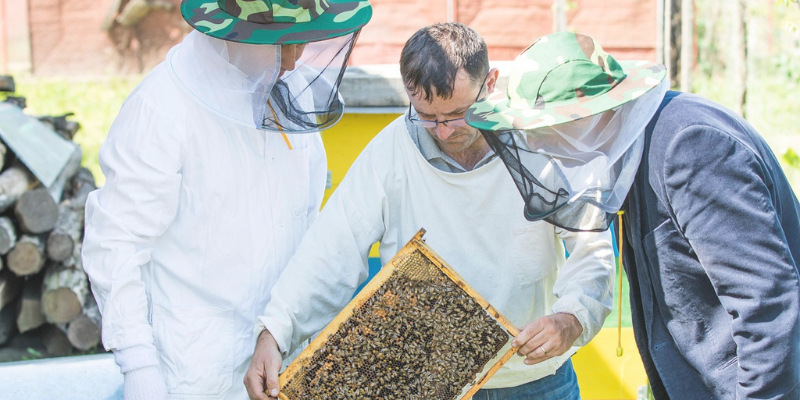News
Growing Your Second Tier: How to Identify and Develop Future Leaders in Your Beekeeping Business
Spotting the Seeds of Leadership
Future leaders don’t always announce themselves. They often start as the quiet operators who take ownership of their work, keep promises, and think ahead. Leadership potential shows up in behaviour long before it appears in a job title.
Look for people who:
-
Take initiative — they see what needs doing without being told.
-
Earn the respect of peers — others naturally turn to them for answers.
-
Stay curious — they ask why, not just how.
-
Handle responsibility with reliability — you can trust their word.
-
Learn fast — they adapt quickly when things change.
These qualities signal more than competence — they reveal character, maturity, and self-motivation. As Jim Collins wrote in Good to Great, “First who, then what.” The right people, once on the bus, will grow into the roles your business needs.

Changing How We Lead: From Telling to Asking
One of the hardest shifts for owners is changing their own habits. Most of us built our businesses by solving problems quickly and telling others what to do. But that approach creates dependency — not leadership.
To grow future managers, you must change from telling to asking.
When a staff member brings you a problem, resist the instinct to answer. Instead, ask:
-
“What options do you see?”
-
“What would you do if I wasn’t here?”
-
“What’s the risk if we try your way?”
As Liz Wiseman explains in Multipliers: How the Best Leaders Make Everyone Smarter, the best leaders don’t have all the answers — they ask better questions. It’s the difference between being the smartest person in the room and creating a room full of smart people.
By leading with questions, you invite thinking, confidence, and ownership. You stop creating followers and start cultivating leaders.
Or as Kevin Murphy puts it in Great Leaders Have No Rules:
“Rules create rule followers. Freedom creates leaders.”
That doesn’t mean chaos — it means setting clear expectations, providing structure, then giving people the space to make decisions and learn.
Creating Pathways for Growth
Potential alone isn’t enough. Future leaders require visible opportunities for growth. Without them, your best people plateau or leave.
Begin by defining what leadership looks like in your business. What does a regional lead or crew leader actually own? What decisions can they make? What results are they accountable for?
Then, give them the chance to prove it. Assign stretch responsibilities such as:
-
Developing the plan for one round of beekeeping activity across multiple apiaries.
-
Leading a region’s pre-spring readiness and reporting on progress.
-
Training or onboarding new seasonal staff using your SOPs.
These assignments provide challenge without risking the whole operation. They teach planning, prioritisation, and communication — the real tools of leadership.
Tie these opportunities to a clear development path. Outline the skills, behaviours, and KPIs that define each level of responsibility — from senior beekeeper to yard manager, then regional manager. When people can see the steps, they can imagine their future.
As Michael Gerber wrote in The E-Myth Revisited, “If your business depends on you, you don’t own a business — you have a job.” Systems and succession are what turn a job into a company.
Coaching and Building Confidence
Once you’ve identified and challenged your future leaders, the next step is to coach them — not just train them. Coaching means creating a safe environment for reflection and growth.
After each round or project, hold short review sessions:
-
What worked well?
-
What didn’t go as planned?
-
What would you do differently next time?
This turns every assignment into a leadership lesson. It builds self-awareness and problem-solving ability, and it models how leaders should review performance with their own teams later.
Adopting a coaching mindset also changes how your people see you. You’re no longer the boss who checks their work — you’re the mentor who helps them think, learn, and lead. That shift builds trust and long-term commitment.
Building a Leadership Culture
True leadership development isn’t a one-time project — it’s a culture. It starts with the owner and filters through every level of the team.
A leadership culture means people feel responsible for outcomes, not just tasks. They know what success looks like and believe they have permission to contribute ideas, make decisions, and own results.
That kind of culture doesn’t remove accountability — it strengthens it. When everyone leads in their space, the business becomes agile, resilient, and less dependent on any one person.
As Ram Charan describes in The Leadership Pipeline, each level of leadership requires a new mindset: from managing self, to managing others, to managing managers. Your job as owner is to help your people make those transitions successfully.
The Payoff: Freedom Through Leadership
Developing a second tier of management takes patience and trust, but the payoff is freedom. Freedom to step back, plan ahead, or even take time away knowing the business will continue to run smoothly.
Leadership development is the ultimate system. It turns good people into capable managers, and it turns your business into something that can grow beyond you.
In the beekeeping world, we know the strength of a hive comes not from a single bee but from how well each one plays its role. The same is true for your business. Build leaders, not followers — and the whole operation becomes stronger.
And if you’d like to dive deeper into the ideas behind leadership and team development, I highly recommend reading the books mentioned in this article. I’ve personally read and applied many of them to my own business, and they’ve shaped how I think about building teams, systems, and leaders who thrive on responsibility.
